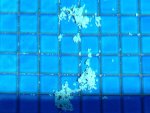We are currently going through the most intense heat wave South Australia has ever experienced. At the moment, the temperature outside is 44.4 degrees Celsius ( 111.92 degrees Fahrenheit).
Because of the high bather load and intense sunlight,I've been running the SWG pump and chlorinator at full blast for the last 2 days with no rest to keep chlorine levels high.
I decided to give it a bit of a rest for an hour or so and found some white clumps had formed at the bottom of the pool.
These formed at the end where the jets are located that deliver the chlorinated water back into the pool. The clumps covered an area of about 2 or 3 square metres. I tried to collect some with the net to examine them more closely but as soon as the net touched them, they disintegrated and converted to tiny white specks that just fell through the net.
I noticed yesterday tiny white specks floating in the water as we were using the pool.
Does anybody know what these might be? Could it be that there is way too much chlorine in the water? My testing kit only goes up to 5 but it seems there is much more in the water than that, as the water in the tester tuns almost blood red when I add the DPD tablet.
Could it be slat? My salt levels have been pretty constant at 5000ppm. I have not added any more.
I've tried attaching a photograph but I'm not sure if it will work (no idea what I'm doing)!
Because of the high bather load and intense sunlight,I've been running the SWG pump and chlorinator at full blast for the last 2 days with no rest to keep chlorine levels high.
I decided to give it a bit of a rest for an hour or so and found some white clumps had formed at the bottom of the pool.
These formed at the end where the jets are located that deliver the chlorinated water back into the pool. The clumps covered an area of about 2 or 3 square metres. I tried to collect some with the net to examine them more closely but as soon as the net touched them, they disintegrated and converted to tiny white specks that just fell through the net.
I noticed yesterday tiny white specks floating in the water as we were using the pool.
Does anybody know what these might be? Could it be that there is way too much chlorine in the water? My testing kit only goes up to 5 but it seems there is much more in the water than that, as the water in the tester tuns almost blood red when I add the DPD tablet.
Could it be slat? My salt levels have been pretty constant at 5000ppm. I have not added any more.
I've tried attaching a photograph but I'm not sure if it will work (no idea what I'm doing)!


